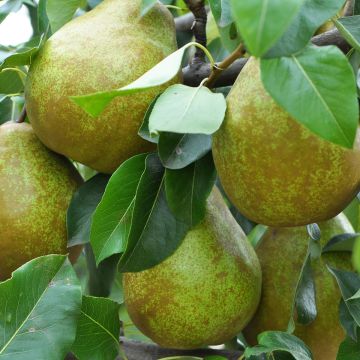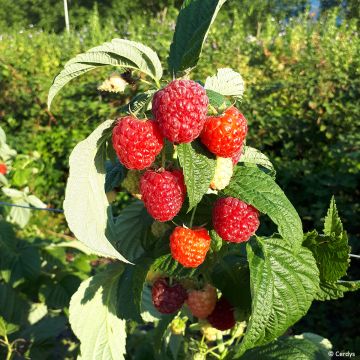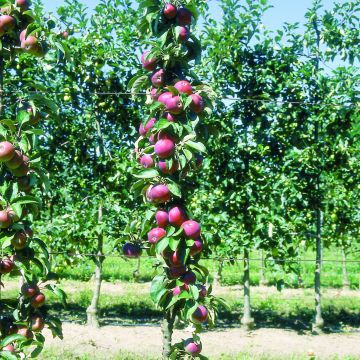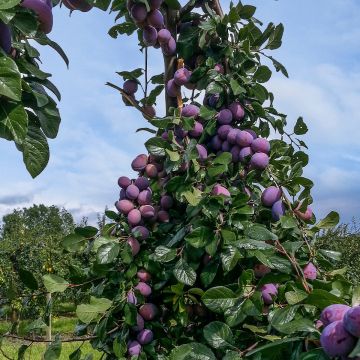

Pyrus communis Obelus - Pear Tree


Pyrus communis Obelus - Pear Tree
Pyrus communis Obelus - Pear Tree
Pyrus communis Obelus®
Common Pear, European Pear
This item cannot be shipped to the selected country
Delivery charge from €6.90
More information
Delivery charge from €6.90
More information
Schedule delivery date,
and select date in basket
This plant carries a 6 months recovery warranty
More information
We guarantee the quality of our plants for a full growing cycle, and will replace at our expense any plant that fails to recover under normal climatic and planting conditions.
From €7.90 for pickup delivery and €6.90 for home delivery
Express home delivery from €8.90.
Description
The Obelisk Pear Tree is a columnar variety that allows for a bountiful harvest with minimal space requirements. It produces medium-sized, slightly rounded pears with green skin speckled with brown and tinged with red in the sun. The creamy white flesh is fine, with a sweet and lightly fragrant, balanced flavour. The harvest takes place in late August and early September. The Obelisk Pear Tree is not self-fertile. It is resistant to scab.
The pear tree is a tree native to central Asia, cultivated in China for 6,000 years. It was introduced to Europe around the 6th century. While its development in the Middle Ages remained limited, there were already 200 varieties by the Renaissance. Since then, the number of varieties has continued to increase. The Obelisk Pear Tree is a columnar variety of horticultural origin.
The Obelisk Pear Tree is not frost-sensitive but it will appreciate protected and sunny locations, avoiding frost-prone and windy situations. It is easy to grow and likes moist and deep soils, but it dislikes overly porous and chalky soils. In winter, provide it with a shovel of wood ash, rich in potash, to improve flowering and fruit quality.
Its columnar habit allows it to have minimal space requirements. It can be grown as a hedge, in a pot on a terrace or balcony, on a trellis... Its oval-shaped leaves are finely toothed on the edge, have a petiole as long as the lamina and measure about 8 to 9 cm (3 to 4in).
Its late white flowering, in late March, protects it from frost. Its flowers are composed of 5 white petals. They are not self-fertile, so plant another pear tree nearby, preferably within a radius of 50 m (164ft). Its main pollinators are the varieties Angelys and Doyenné du Comice.
This variety produces medium-sized, slightly rounded pears with green skin speckled with brown and tinged with red in the sun. The creamy white flesh is fine, with a sweet and lightly fragrant, balanced flavour.
Pears can be consumed fresh, in syrup, in pastries, in jams and compotes, and can be used to make alcoholic beverages...
Pyrus communis Obelus - Pear Tree in pictures


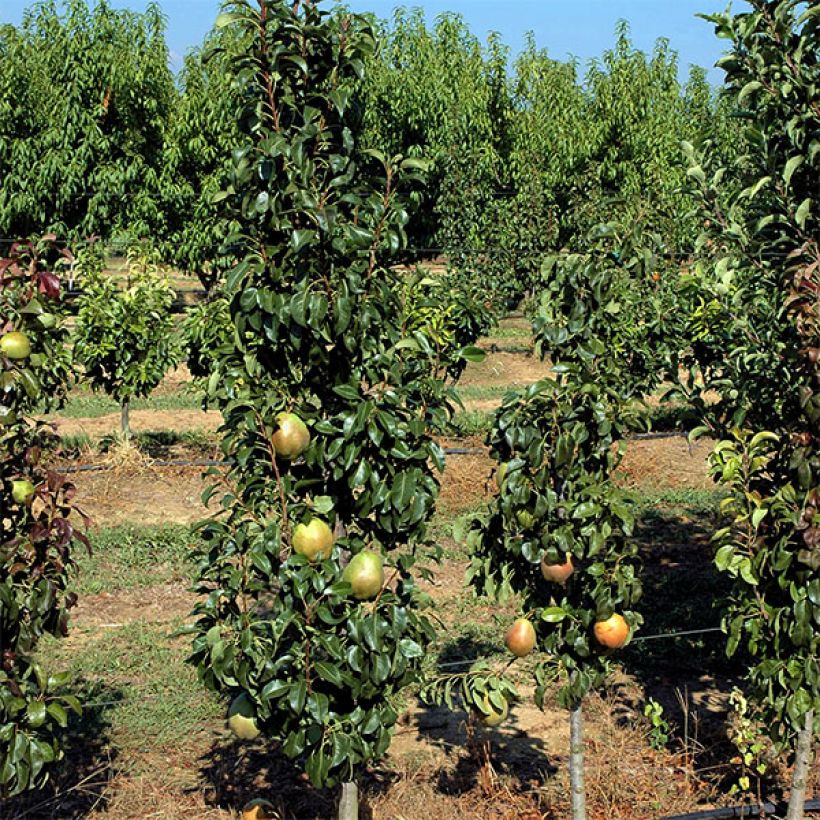

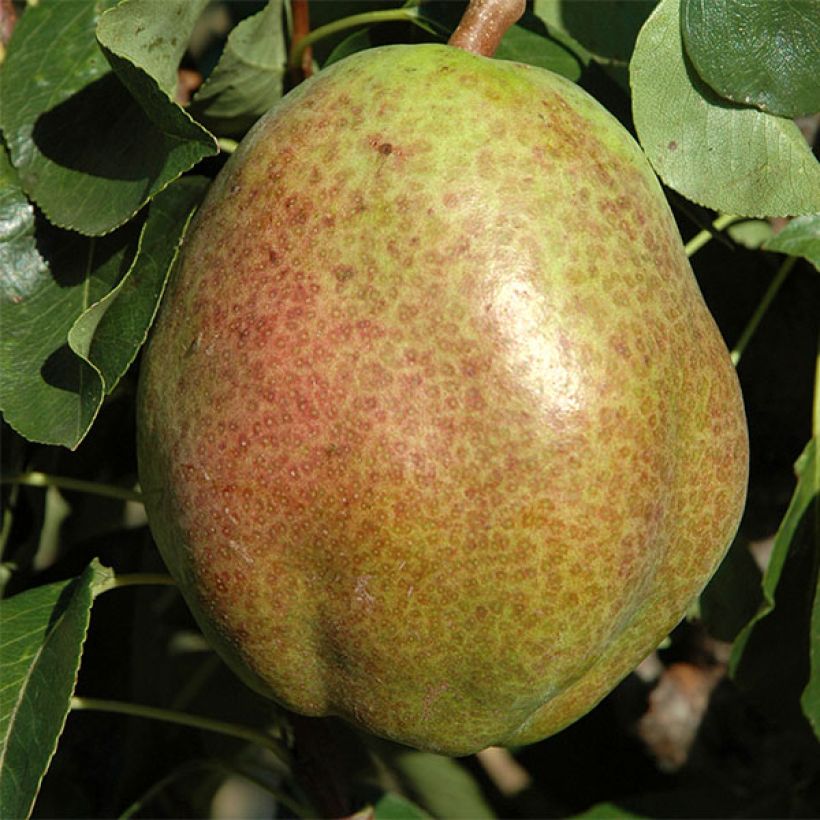

Plant habit
Fruit
Flowering
Foliage
Botanical data
Pyrus
communis
Obelus®
Rosaceae
Common Pear, European Pear
Cultivar or hybrid
Other Pear trees
View all →Planting and care
Plant the Obelisk Pear Tree in a sunny location, in acidic or neutral, moist but not wet soil. Ensure good drainage with a thin layer of gravel in the planting hole. Dig a hole two to three weeks before planting, twice as wide and deep as the pot. On planting day, place the tree with its pot in water, allowing the entire root ball to be moistened. Add compost to the bottom of the hole. Place the tree in the hole and fill it with a mixture of soil and compost. Do not bury the grafting union. Firm down the soil around the base. The root ball should be completely covered. Water thoroughly.
You can add a small handful of wood ash, rich in potash, during winter to improve fruiting.
Planting period
Intended location
Care
Planting & care advice
Fruit trees for small gardens
Haven't found what you were looking for?
Hardiness is the lowest winter temperature a plant can endure without suffering serious damage or even dying. However, hardiness is affected by location (a sheltered area, such as a patio), protection (winter cover) and soil type (hardiness is improved by well-drained soil).

Photo Sharing Terms & Conditions
In order to encourage gardeners to interact and share their experiences, Promesse de fleurs offers various media enabling content to be uploaded onto its Site - in particular via the ‘Photo sharing’ module.
The User agrees to refrain from:
- Posting any content that is illegal, prejudicial, insulting, racist, inciteful to hatred, revisionist, contrary to public decency, that infringes on privacy or on the privacy rights of third parties, in particular the publicity rights of persons and goods, intellectual property rights, or the right to privacy.
- Submitting content on behalf of a third party;
- Impersonate the identity of a third party and/or publish any personal information about a third party;
In general, the User undertakes to refrain from any unethical behaviour.
All Content (in particular text, comments, files, images, photos, videos, creative works, etc.), which may be subject to property or intellectual property rights, image or other private rights, shall remain the property of the User, subject to the limited rights granted by the terms of the licence granted by Promesse de fleurs as stated below. Users are at liberty to publish or not to publish such Content on the Site, notably via the ‘Photo Sharing’ facility, and accept that this Content shall be made public and freely accessible, notably on the Internet.
Users further acknowledge, undertake to have ,and guarantee that they hold all necessary rights and permissions to publish such material on the Site, in particular with regard to the legislation in force pertaining to any privacy, property, intellectual property, image, or contractual rights, or rights of any other nature. By publishing such Content on the Site, Users acknowledge accepting full liability as publishers of the Content within the meaning of the law, and grant Promesse de fleurs, free of charge, an inclusive, worldwide licence for the said Content for the entire duration of its publication, including all reproduction, representation, up/downloading, displaying, performing, transmission, and storage rights.
Users also grant permission for their name to be linked to the Content and accept that this link may not always be made available.
By engaging in posting material, Users consent to their Content becoming automatically accessible on the Internet, in particular on other sites and/or blogs and/or web pages of the Promesse de fleurs site, including in particular social pages and the Promesse de fleurs catalogue.
Users may secure the removal of entrusted content free of charge by issuing a simple request via our contact form.










































